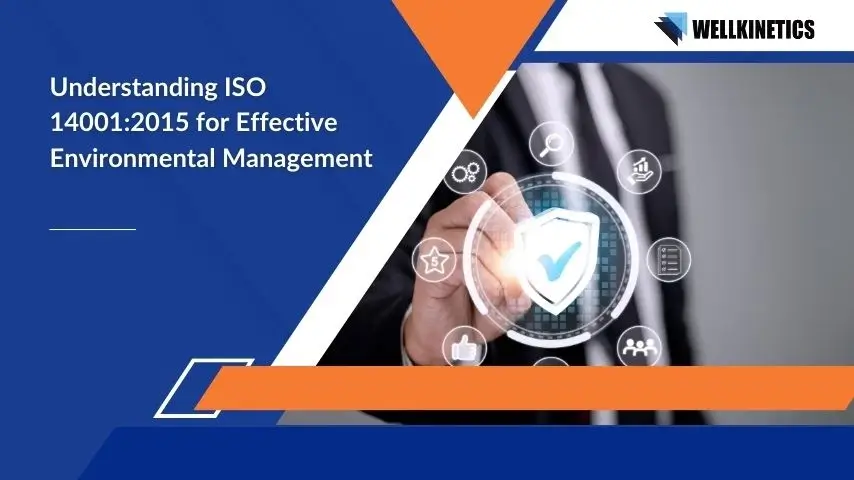ISO 14001:2015 is an internationally recognized standard that specifies the requirements for an effective Environmental Management System (EMS). It provides a framework that organizations can follow to enhance their environmental performance while fulfilling compliance obligations. The primary goal of ISO 14001 is to improve environmental outcomes by minimizing adverse impacts on the environment and ensuring sustainable resource management.
In this article, we will explore the importance of implementing ISO 14001:2015 and how it can benefit a wide range of stakeholders, from businesses to the broader community. Additionally, we’ll look at how organizations can integrate ISO 14001 with other management standards for enhanced efficiency, and discuss the common challenges faced during implementation.
Whether you’re looking to implement ISO 14001:2015 for the first time or seeking ways to optimize your existing EMS, this article will provide valuable insights to guide your journey towards environmental excellence.
- What is ISO 14001:2015?
- Why Implement ISO 14001:2015?
- Who Benefits from ISO 14001:2015?
- What are the Benefits of ISO 14001:2015 Implementation?
- Why Should Organizations Integrate ISO 14001 with Other Standards?
- What are the Challenges of Integrating ISO 14001 with Other Management Systems?
- How Wellkinetics Can Help
What is ISO 14001:2015?
ISO 14001:2015 is an internationally recognized standard that provides a structured framework for organizations to manage their environmental responsibilities. It emphasizes the importance of an Environmental Management System (EMS) in promoting sustainable practices and reducing the overall environmental impact. By adhering to ISO 14001, companies can enhance regulatory compliance, improve environmental performance, and demonstrate their commitment to corporate sustainability.
The significance of ISO 14001 lies in its ability to help organizations effectively evaluate and mitigate environmental risks while also fostering continuous improvement. This standard encourages entities to develop an environmental policy that reflects their commitment to preventing pollution, enhancing resource management, and engaging stakeholders in their efforts to achieve sustainability.
Why Implement ISO 14001:2015?
Implementing ISO 14001:2015 offers numerous advantages for organizations aiming to enhance their environmental performance and sustainability practices. Here are several key reasons to consider adopting this standard:
1. Regulatory Compliance: By aligning with ISO 14001, organizations can better navigate the complex landscape of environmental regulations. The standard helps ensure that all necessary legal obligations are met, reducing the risk of non-compliance and potential fines.
2. Risk Management: ISO 14001 provides a systematic approach to identify, assess, and manage environmental risks. This proactive stance not only minimizes harmful impacts on the environment but also protects organizational reputation and financial stability.
3. Cost Savings: Effective implementation of an Environmental Management System can lead to significant cost reductions. By adopting sustainable practices, organizations can lower waste disposal fees, increase efficiency in resource use, and reduce energy consumption, ultimately resulting in financial savings.
4. Stakeholder Confidence: Adopting ISO 14001 enhances an organization’s credibility with stakeholders, including customers, investors, and employees. Demonstrating a commitment to environmental responsibility can improve stakeholder loyalty and trust, making your organization more attractive in a competitive market.
5. Continuous Improvement: One of the core principles of ISO 14001 is the commitment to ongoing improvement. Organizations are encouraged to regularly evaluate their processes and systems, seek feedback, and implement changes that lead to better environmental outcomes. This culture of continuous improvement can foster innovation and keep organizations ahead of changing regulatory requirements.
Get Started with ISO 14001 Certification
Start your ISO 14001 journey today with expert guidance tailored to your business.
Who Benefits from ISO 14001:2015?
ISO 14001:2015 benefits a wide range of stakeholders, including but not limited to:
1. Organizations of All Sizes: Whether large corporations or small businesses, any organization committed to reducing its environmental footprint can benefit from implementing ISO 14001. The standard provides a scalable framework that can be adjusted to suit the specific needs and resources of various types of organizations.
2. Employees: Workers play a vital role in the success of an Environmental Management System. By involving employees in environmental initiatives and decision-making processes, organizations foster a sense of ownership and pride in their workplace. ISO 14001 promotes a culture of sustainability that can enhance employee motivation and retention.
3. Customers: Today’s consumers are increasingly eco-conscious and often prefer to support businesses that demonstrate a commitment to environmental stewardship. Implementing ISO 14001 can help organizations meet this demand, improving customer satisfaction and loyalty.
4. Regulatory Authorities: Governments and regulatory bodies benefit from ISO 14001’s structured approach to compliance. By encouraging companies to adhere to environmental regulations and best practices, the standard helps promote a level playing field and protect public resources.
5. Communities: Local communities benefit when organizations actively manage their environmental impact. By reducing pollution and promoting responsible resource management, companies can enhance the quality of life for residents and contribute to broader sustainability efforts within their areas.
6. Suppliers and Partners: Organizations that implement ISO 14001 often encourage their suppliers and partners to adopt similar environmental practices. This creates a ripple effect throughout the supply chain, promoting sustainability and responsible resource management at every level. By working collaboratively, businesses and their partners can mutually benefit from improved practices and shared commitments to environmental responsibility.
7. Investors and Financial Institutions: Investors are increasingly considering environmental, social, and governance (ESG) factors when making decisions. Companies with ISO 14001 certification demonstrate a structured approach to managing environmental impacts, which can make them more attractive investment options. Financial institutions may also view these organizations as lower risk due to their commitment to sustainability and compliance with environmental regulations.
What are the Benefits of ISO 14001:2015 Implementation?
Implementing ISO 14001:2015 offers various advantages that extend beyond compliance and risk management. Below are some key benefits organizations can expect:
1. Enhanced Environmental Performance: ISO 14001 encourages organizations to set and achieve measurable environmental objectives. Through systematic planning, execution, and review of an Environmental Management System (EMS), businesses can track their environmental performance and identify areas for improvement, leading to significant reductions in their ecological impact.
2. Increased Market Opportunities: As consumer awareness of environmental issues grows, many businesses are seeking certification to reputable standards such as ISO 14001. This certification can differentiate organizations in the market, making them more appealing to environmentally conscious consumers and other stakeholders, potentially opening new pathways for business opportunities.
3. Improved Compliance with Legal Requirements: ISO 14001 facilitates a better understanding of applicable environmental laws and regulations. By adopting this standard, organizations can ensure they stay compliant with current legal requirements, reducing the risk of penalties and fines associated with non-compliance.
4. Employee Engagement and Morale: Involvement in environmental initiatives can boost employee morale and job satisfaction. When workers see their organization actively pursuing sustainability efforts, it fosters a sense of pride and belonging, leading to higher productivity and lower turnover rates.
5. Positive Brand Image: Organizations that prioritize environmental responsibility often see an enhancement in their brand image. Consumers today are increasingly influenced by a company’s environmental track record, and businesses that demonstrate a commitment to sustainability can differentiate themselves from competitors. This positive brand perception not only attracts new customers but also strengthens relationships with existing clients.
6. Operational Efficiencies: Implementing an Environmental Management System (EMS) under ISO 14001 can help organizations streamline processes and reduce waste. By identifying inefficiencies and areas where resources can be saved, businesses can lower operational costs while minimizing their environmental footprint. This can lead to improved profit margins and a more sustainable business model.
7. Risk Management and Resilience: ISO 14001 encourages organizations to assess potential environmental risks and establish proactive strategies to mitigate them. By understanding and managing these risks effectively, businesses can enhance their resilience to environmental challenges, such as regulatory changes or natural disasters, ultimately ensuring long-term sustainability.
8. Access to New Markets: Some markets and clients require environmental certification as a prerequisite for doing business. By obtaining ISO 14001 certification, organizations can open doors to new markets that prioritize sustainable practices, access government contracts, or engage with environmentally responsible partners, thereby expanding their reach and potential for growth.
Why Should Organizations Integrate ISO 14001 with Other Standards?
Integrating ISO 14001 with other standards is essential for organizations looking to enhance their overall management performance. By aligning their environmental management system (EMS) with other established frameworks, businesses can streamline processes, improve resource utilization, and achieve multiple objectives simultaneously. Here are some key points to consider when integrating ISO 14001 with other standards:
1. Common High-Level Structure (HLS)
Many ISO standards, including ISO 14001, utilize the High-Level Structure (HLS) established by Annex SL. This common framework facilitates a more straightforward integration process, as organizations can follow a similar structure for different management systems. It promotes consistency in policies, objectives, and processes across various functions, thus enhancing organizational cohesion.
2. Holistic Management Approach
By integrating ISO 14001 with other management systems such as ISO 9001 (Quality Management) and ISO 45001 (Occupational Health and Safety), organizations can adopt a holistic approach to management. This means that while achieving environmental goals, they can also ensure quality and safety are prioritized in their operations. This interconnectedness fosters a comprehensive understanding of how each area impacts the others.
3. Increased Efficiency and Cost Savings
By integrating ISO 14001 with other management standards, organizations can eliminate redundant processes and streamline operations, leading to increased efficiency. Shared documentation and combined internal audits reduce the need for separate assessments, saving time and resources. This integrated approach can result in significant cost savings while maintaining compliance with multiple standards.
4. Risk Management Synergies
An integrated management approach allows organizations to develop a comprehensive risk management strategy that considers environmental, quality, and occupational health and safety risks collectively. This holistic view supports the identification of potential issues across different areas, enabling organizations to implement preventive measures and mitigate risks more effectively.
5. Enhanced Reporting and Accountability
By integrating ISO 14001 with other standards, organizations can streamline their reporting processes, creating a unified framework for tracking performance across various management disciplines. This not only simplifies reporting but also promotes greater accountability, as stakeholders can assess performance metrics across environmental, quality, and safety parameters in a consolidated view.
6. Strengthened Compliance and Certification Efforts
Organizations that integrate ISO 14001 with other ISO standards may find it easier to achieve and maintain certification. This integrated approach minimizes the complexity of compliance requirements by allowing organizations to align their processes with multiple standards simultaneously. As a result, the likelihood of meeting the necessary benchmarks for certification increases, which can enhance an organization’s reputation and credibility in the marketplace.
7. Fostering a Safety Culture
Integrating ISO 14001 with other management standards serves to foster a safety culture within organizations. By aligning environmental management practices with health and safety considerations from ISO 45001, companies create a work environment that values both employee welfare and environmental protection. This dual emphasis not only protects the workforce but also demonstrates to employees that their well-being is a priority, ultimately leading to higher morale and productivity.
8. Improved Resource Efficiency
Integrating ISO 14001 with other management systems encourages organizations to optimize resource use and minimize waste. By adopting a systematic approach to resource management, organizations can identify inefficiencies, streamline operations, and implement sustainable practices that reduce costs and environmental impact. This efficiency not only enhances operational effectiveness but also supports long-term sustainability goals.
Struggling with the complexities of integrating ISO 14001 with other management systems?
Wellkinetics can guide your organization through the process, ensuring efficiency, compliance, and cost savings.
What are the Challenges of Integrating ISO 14001 with Other Management Systems?
Integrating ISO 14001:2015 with other management systems, such as Quality Management (ISO 9001) or Occupational Health and Safety (ISO 45001), can present several challenges. However, overcoming these obstacles can lead to a more unified framework for achieving both organizational objectives and sustainability goals. Key challenges include:
1. Cultural Resistance
One of the most common challenges during integration efforts is resistance to change within the organization’s culture. Employees may be accustomed to existing processes and hesitant to adopt new practices. To overcome this, organizations should prioritize change management strategies that involve clear communication about the benefits of integration, along with training programs to ensure all employees understand the new methods.
2. Resource Allocation
Integrating multiple management systems may necessitate additional resources, including time, personnel, and finances. Organizations should carefully assess and allocate resources to support the integration process. This may involve appointing dedicated teams to oversee the integration efforts and providing ongoing training to ensure employees have the skills needed to adapt to new processes.
3. Complexity of Compliance
Balancing compliance with multiple standards can be challenging, especially for organizations with limited experience in managing diverse regulatory requirements. Creating a comprehensive compliance framework that encompasses the requirements of each standard within the integrated management system is crucial. Best practices include periodic reviews of compliance obligations and leveraging technology to streamline compliance tracking and reporting.
4. Interdepartmental Coordination
Effective integration of ISO 14001 with other management systems requires close collaboration between different departments. This can be difficult, as teams may have distinct priorities and objectives. To foster interdepartmental coordination, organizations should establish cross-functional teams that facilitate communication and collaboration. Regular meetings and shared goals can help align efforts and ensure that all departments are working towards common objectives.
5. Knowledge Gaps
Another challenge organizations may face is knowledge gaps regarding the standards being integrated. Employees may not fully understand the principles or requirements of ISO 14001 or other management systems involved. To bridge these gaps, organizations should invest in comprehensive training programs and provide accessible resources that explain each standard’s significance and how they interrelate. Additionally, mentorship opportunities can enhance learning and build expertise among staff.
6. Maintaining Focus on Core Objectives
During the integration process, organizations might risk losing sight of their core objectives. The complexity of aligning multiple standards can lead to distraction from the primary goals of improving environmental performance and ensuring sustainability. It is important for organizations to maintain a clear focus on their mission and objectives throughout the integration. This can be achieved by developing a strategic plan that outlines specific outcomes of the integration and regularly assessing progress toward those goals.
How Wellkinetics Can Help
At Wellkinetics, we specialize in providing comprehensive solutions that ensure a seamless and efficient integration of ISO 14001:2015 standards. Our approach is structured, client-focused, and designed to enhance your organization’s environmental practices while ensuring compliance. Here’s how we can support your journey toward ISO 14001 certification:
1. Gap Analysis: Our team will conduct a thorough assessment of your current environmental practices, comparing them with the requirements of ISO 14001:2015 standards. Through project planning and both desktop and physical document reviews, we will identify gaps and recommend strategic improvements to align your systems with best practices.
2. Strategic Planning: We help you develop a clear, actionable strategy to implement ISO 14001:2015. This includes training your team on the standards, documentation structure, and aspect-impact assessments. Our tailored strategic planning ensures that the entire organization understands the necessary steps for effective implementation.
3. System Development: Our experts will assist in the development of new documentation and business processes that comply with ISO 14001:2015 standards. This structured approach ensures your organization establishes the right foundations for sustainable environmental management and meets regulatory requirements.
4. Implementation: We offer holistic support to implement ISO 14001:2015 across your entire facility. Our team works with you to integrate the standards seamlessly into your operations, ensuring that your environmental management system is both effective and sustainable.
5. Internal Audit: Wellkinetics conducts a final review and internal audit to assess the effectiveness of your ISO 14001 program implementation. Our audit process identifies areas of strength and opportunities for improvement, ensuring that your environmental management system operates at its full potential.
6. External Audit Support: Our team will assist in addressing any findings from the external certification audit. We ensure that all issues are effectively closed out and provide continuous support to ensure the successful certification of your environmental management system.
Learn more about our Environmental Consultancy Services.




